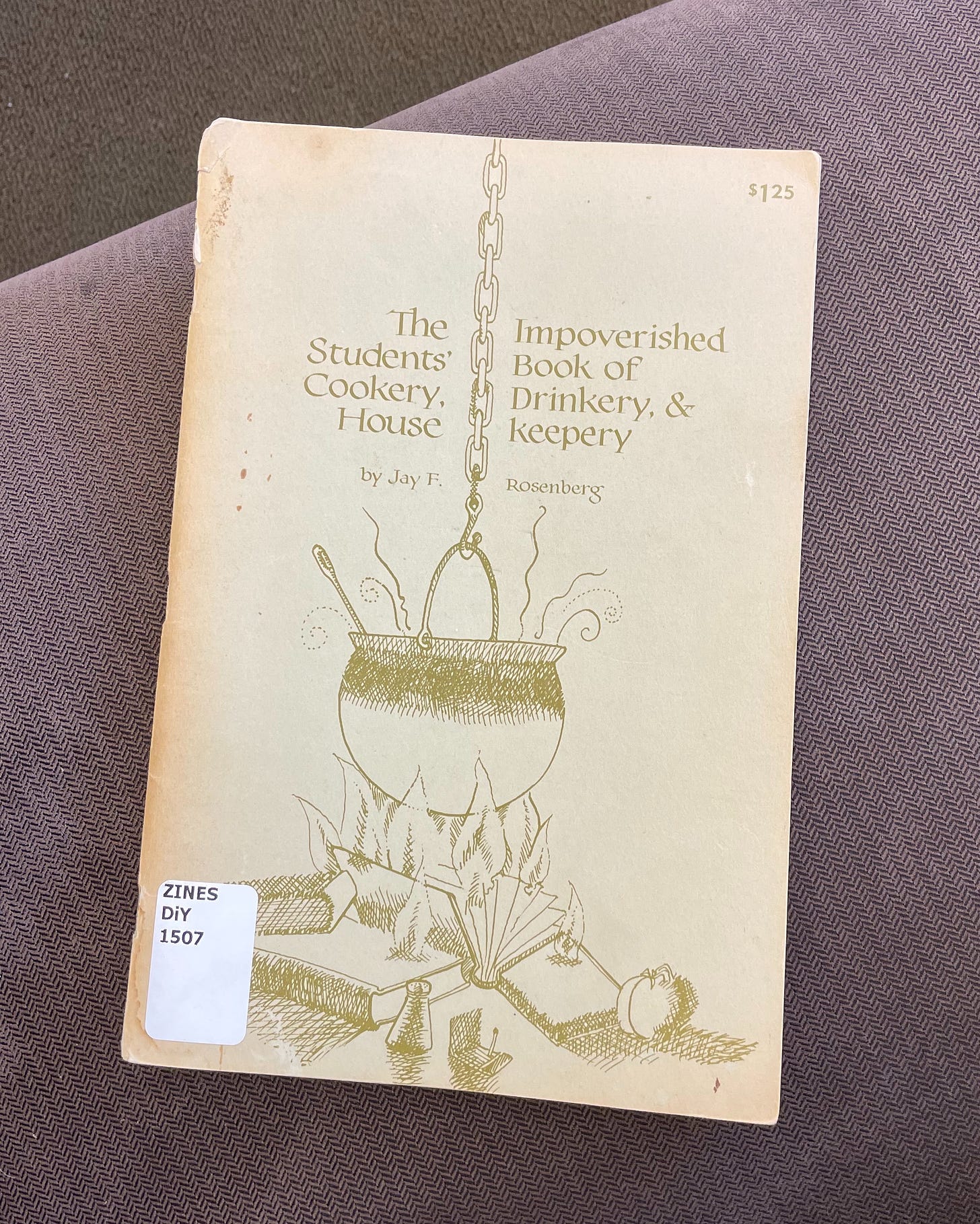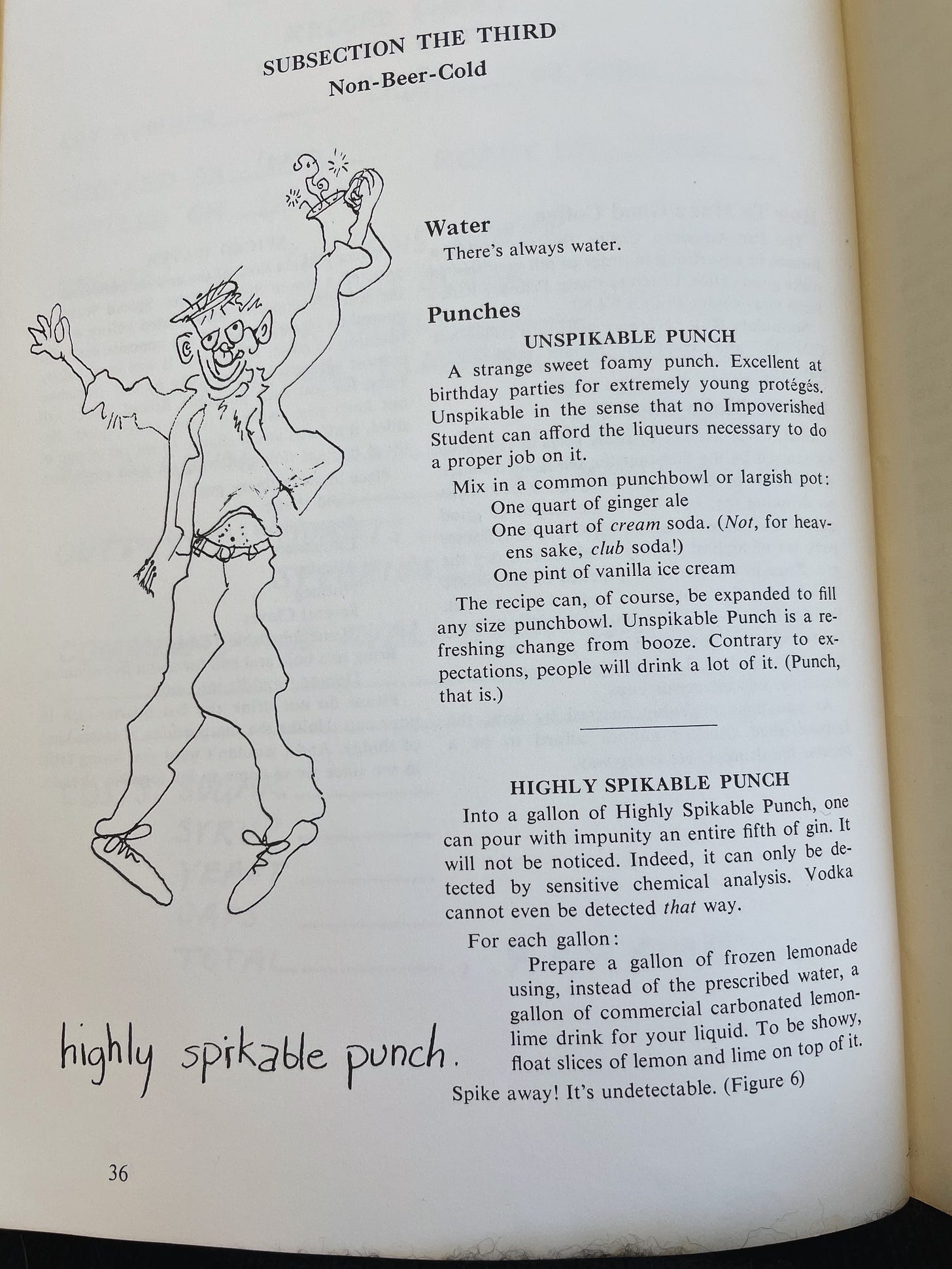Hello my dears,
I’m back, I’m back. A few more weeks off than expected, for which I apologize. A hazy combination of ten days up at Bennington, a weeks-long headache (“status migraine”), the last bits of work for a project that will be done yesterday. I keep thinking I’ll write when I’m up at school but it’s impossible, the days are packed, all I can do is keep my head above water. And occasionally steal away to the library, whose second floor holds a zine library, a little play place for the distracted reader. The other day I sat on the floor and combed through it.
In the DIY section I found a booklet from 1965 called The Impoverished Student’s Book of Cookery, Drinkery, & House Keepery, though the first time I read the cover I thought it was The Students’ Cookery House Impoverished Book of Drinkery & Keepery. I like to think the confusion was intentional, or at least the duplicity was knowingly allowed. The cover shows a cauldron steaming atop a fire made from books, with a salt shaker and an apple and a matchbook bathing in the glow.
The booklet’s author, Jay F. Rosenberg1, defines the titular impoverished student in the book’s introduction. I’m sorry, no, it’s not an introduction, it’s a prolegomena. Rosenberg explains that the impoverished student he writes for is not necessarily financially impoverished2—many are in fact moneyed, you know the type—but impoverished by way of meagre dining hall options, and defined by their desire for good food.
Above all, it is a playful text, dead serious about its goofiness. It immediately invents its own world. The first thing you find after the title page is an elaborate decision tree, far more conceptual than the table of content that follows. For example if you are NOT a novice impoverished student and you DON’T want to make a main dish but you DO want to cook up some vegetables, you can head to page 22. (This was one of the less baroque examples to offer you.) Thumbing through it, you begin to feel that Rosenberg is a sort of Laurie Colwin in the body of a midcentury Reed College student3.
This is a cookbook that requires a game reader. Some recipes from friends are quoted verbatim, with little concern for detailed advice. Instructions often come in dense blocks; ingredient lists don’t include spices, a battery of which has been laid out for you in an earlier section. Recipes are not uniformly formatted or edited, but instead written at Rosenberg’s whim, and they brim with his voice. There is an essay on horsemeat4. Sometimes, midway through a recipe, he will yell at you: ADD ENOUGH VINEGAR SO THAT YOU CAN SMELL IT! The whole thing has the careening anecdotal energy of someone holding court at a dinner party, endearingly caught up in his own lore. Either you want to go on this strange little journey with him or you don’t; I did.
Most endearing to me were the little additions he’d make to listed ingredients, such as in Sondheim’s5 Tuesday Night Special:
1 1/2 lb. crab or lobster (!)
the yolks only (believe it or not!) of 3 eggs
After he instructs to cook until it tastes good he jumps to the next line defensively and says “I don’t know what you do with the whites of three eggs.”
As you’ll see this guy absolutely does not give a shit about normative recipe forms. And while I don’t want to over-indulge the sort of midcentury man who attended Reed College (just imagine the obscure poetry he would recite and the stains he’d leave on your nice tablecloth and all the sherry he’d drink if you invited him over to dinner), reading through the book made me hungry for more of this textual looseness.
Whether you’re reading the latest glossy Clarkson Potter release or NYT Cooking or one of the last remaining food magazines, you can rest assured that each recipe you read has not only been tested multiple times but edited within an inch of its life. This is for your benefit! Today’s recipe landscape is so flooded, and its consumers so busy, that a recipe must be punchy it must be reliable it must be legible. And it must adhere to its publication’s style guide. How many hours have been spent wavering over teaspoon versus tsp! I’m still unsure of the Mess Hall stance on these things, though in my Food52 days I had very strong feelings.
When I spoke with Rebecca May Johnson in December, I asked her about the launch of recipes at Vittles, where she is. an editor. And she explained (as I remember it) that those recipes would be tested by a recipe tester who would offer feedback, but the author would have final say. There was no style guide. As with any dish, the recipe would hold the unique mark of the cook who wrote it. (Read Melek Erdal, on the reluctant translation of Kurdish cooking into words.) When I heard this I loved the idea and also became conscious of the ways that I often tailor my recipes away from my voice and towards standardization. Not a bad thing, per se—if I print a recipe here, I want you to be able to use it, to find pleasure and success in it. An illegible recipe is most often an uncooked recipe.
But I am always looking for recipes that break form, or try to create their own. As Alicia Kennedy wrote last year6, “independent publishing has allowed for more voice and specificity in recipe writing, breaking through the false ideas proffered by big outlets that everyone is living in the same season with the same access.” She was writing, in part, about the ways that recipes are produced—on Patreon and email newsletters, not just glossy magazines. These venues often enable a “casual and intimate” relationship between writer/cook and reader/cook, outside of the stuffy strictures of legacy media. Formal aberration and authorial intrusions in ingredient lists or instructions do this too, creating dialogue and rapport between these two parties. I thought of Rosenberg’s parentheticals when reading Ali Slagle’s latest recipe, which calls for 1 juicy lemon (or 2 duds). We have fun out here in the wild west of cooking newsletters.
The book that TISBOCD&HK made me think of most was Dorothy Iannone’s A Cookbook. Another text similarly unconcerned with perfect utility, but built from recipes that have been honed and adored and embellished with permanent marker. I take issue with cookbooks that reject utility for the sake of doorstop-style aesthetics; I’ve written before about how angry Daniel Patterson’s Coi made me as a young editor, with its soulless coffee table photos sweeping the recipes to the back pages. But a book packed with recipes that may or may not work out for you, which have flowed forth from the mouth of some strange artist or “impoverished student”, is far more interesting to me because of the narratives these recipes carry on their oddly shaped wings.
Perhaps what I am really circling here is the idea of the amateur recipe. Not in its untestedness, but in its style. People love to ooh and ahh about, like, church cookbooks and Junior League cookbooks; they’re fascinating cultural documents, yes, but they are also blissfully free from the professional editor’s pen. They contain a voice, and a palate: a mouth, speaking to the page, through the hand that flips the pancake.
One great bit of utility that TISBOCD&HK offered me was a reminder of the casserole as a form. I am almost never making a casserole. Perhaps because I am usually cooking for one or maybe two, which creates a looming question of leftovers. Rosenberg’s TOOMANY CASSEROLE hides an important truth behind a cheeky name: that sometimes you have eaten too many casseroles (or in my case too many bowls of pasta, pots of beans), and you need proof that the casserole (or dinner in general) can be an “exciting, dynamic experience.”
I share this recipe not because I have cooked it or tasted it, but because I find it delightful, and maybe you will too. I have kept its original formatting intact.
TOOMANY CASSEROLE
1 lb Ground Beef
1 eight-slice package of mild Cheddar Cheese
2 small cans of peeled mild green cjili peppers
1 package of large noodles
Clean the seeds out of the chili peppers. (This being a long, sloppy job, yet well worth the effort.) Slice the de-seeded chili peppers into little pieces. Precook the noodles. Sauté the meat in butter and onion and whole garlic (which has been cut up into small chunks). Season with: Salt Pepper Chili Powder Cumin Paprika And a little bit of Cayenne. Drain off all the fat. Stir in the chopped chili peppers into the sautéed meat. Beginning with noodles, alternate in your casserole dish layers of noodles, meat-peppers mixture, and cheese. End, as usual, with the cheese. Bake in a 350° oven for about 20 minutes or until the cheese is melted.
Toomany Casserole does not taste like anything else. Most particularly, it does not taste like what the reader by now doubtless expects it should taste like. It tastes better. It will unjade the tastes of your compatriots.
If you have a favorite strange/amateur cookbook PLEASE TELL ME ABOUT IT IN THE COMMENTS :D
Fittingly it seems that Rosenberg went on to become a philosophy professor, win a Guggenheim fellowship, win $50,000 on Jeopardy!, and publish several “serious” books. Crazy to think that during the last two years of his life we were both living in Chapel Hill, NC. RIP to a true freak <3
Here he differentiates between MERELY IMPOVERISHED and TRULY IMPOVERISHED—the latter of course being the broke student, the former just aesthetically hungry.
Also fittingly, the pamphlet was published by the Reed College Alumni Association
“…in which the author undertakes to explore the springs and principles underlying the commonly-found aversion toward eating the flesh of the horse, brings to bear some corrective considerations which, hopefully, may serve to lessen the illogic of the well-entrenched opposition to said practice, and issues a definitive challenge to those remaining unconvinced by the abovementioned arguments and investigations—the whole concluded by a piece of good news for the consumer.”
Not that Sondheim, apparently
Revisiting this essay also has me revisiting Tamar Adler on old recipes—so good






I review cookbooks & have found myself appalled at the way instructions go off the rails, sometimes amateurs writing, but sometimes names we know & like & think we can trust. I'm thinking here about the way basic methods, like mixing a butter cake in a basic baking cookbook, go out the window. I could easily vote for going back to "bring to boil, reduce to simmer" standardization. It's just too often I see things a good editor would catch, like 2 whole cloves swimming freestyle in a Dutch oven filled w braised red cabbage. My answer is to write out an ingredient list in a size I can see, bracketing and shoe-horning into known methods where I can also find my place when I go back to the recipe. And I'd rather not have to scrub recipes so much. A good book designer should be able to handle many of the issues I don't care to see.
Your text was beautiful and insightful, thank you! I am currently reading: The Medieval Kitchen, ed. by Odile Redon, Françoise Sabban and Silvano Serventi; a collection of medieval French an Italian Dishes. The original text is kept, but commented on by the editors. Unlike anything I’ve ever read.